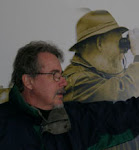One of my students introduced me to this fabulous Cuban-born, lyric poet -- Carilda Oliver Labra.
Eve's Discourse Today, I brutally greet you
with a grunt
or a kick.
Where are you hiding,
where have you fled with your wild box
full of hearts,
and your stream of gunpowder?
Where are you now;
in the ditch where all dreams are finally tossed,
or in the jungle's spidery web
where fatherless children dangle?
I miss you,
you know I do--
as myself
or the miracles that never happen--
you know I do?
I'd like to entice you with a joy I've never known,
an imprudent affair.
When will you come to me?
I'm anxious to play no games,
to confide to you: "my life"--
to let thunder humble us
to let oranges pale in your hand.
I want to search your depths
and find veils
and smoke,
that will vanish at last in flame.
I love you truly
but innocently
as the transparent enchantress of my thoughts,
but, truly, I don't love you,
though innocently
as the confused angel that I am.
I love you,
but I don't love you.
I gamble with these words
and the winner shall be the liar.
Love!. . .
(What am I saying? I'm mistaken,
because here, I wanted to write, I hate you.)
Why won't you come to me?
How is it possible
you let me pass by without requiting our fire?
How is it possible you're so distant, so paranoid
that you deny me?
You're reading the newspapers
passing through
death
and life.
You're with your problems
of groans and groin,
listless,
humiliated,
entertaining yourself with an aspiration to mourning.
Even though I'm melting you,
even though I insult you,
bring you a wilted hyacinth
approve your melancholy;
call forth the salt of heaven,
stitch you into being:
What?
When are you going to murder me with your spit,
hero?
When are you going to overwhelm me again beneath the rain?
When?
When are you going to call me your little bird,
your whore?
When are you going to profane me?
When?
Beware time that passes,
time,
time!
Not even your ghosts appear to me now,
and I no longer understand umbrellas?
Every day, I become more honest with myself,
magnificently noble. . .
If you delay,
if you hesitate and don't search for me,
you'll be blinded;
if you don't return now,
infidel, idiot, dummy, fool,
I'll count myself nothing.
Yesterday, I dreamt that while we were kissing,
a shooting star exploded
and neither of us gave up hope.
This love of ours
belongs to no one;
We found it lost,
stranded
in the street.
Between us we saved it, sheltered it.
Because of that, when we swallow each other
in the night,
I feel like a frightened mother left
alone.
It doesn't matter,
kiss me again and over again
to come to me.
Press yourself against my waist,
come to me again;
be my warm animal again,
move me, again.
I'll purify my leftover life,
the lives of condemned children.
We'll sleep like murderers
who've saved themselves
by bonding together in incomparable blossoming.
And in the morning when the rooster crows,
we will be nature, herself.
I'll appear like your child asleep in her cradle.
Come back to me, come back,
penetrate me with lightening,
Bend me to your will.
We'll turn the record player on forever.
Bring me that unfaithful nape of your neck,
the blow of your stone.
Show me I haven't died,
my love, and I promise you the apple.
My Mother You Are in a Letter from MiamiMy mother, you're only in a letter
and in an old scolding that I couldn't find;
stay here forever in the center
of a blooming rose that never dies.
My Mother, so far away, tired
of snow and mist. Wait, I'm coming
to bring you home to live with the sun inside you,
My Mother, who lives in a letter.
You can give a date to mystery,
that would blend with bewitching shadows;
you can be the stone rolled away,
you can evaporate the circles under your eyes;
but remember, your small daughter, Mother.
Don't dare to do all you can do; don't die.
The Boy Who Sells GreensYou have no parents; it’s clear...I know
because of your indecisive look.
I can tell because of your shirt.
You are small but grown up behind the basket.
You respect the sparrows. A penny is enough for you.
The people pass dressed inside with steel.
They don't listen to you...You have shouted
two or three times: "Greens!"
They pass indifferently carrying packages and umbrellas;
in new pants and new yellow blouses;
They walk in a hurry toward the bank and the tedium
or toward the sunset through Main Street. . .
And you're not selling: you do the game of selling;
and although you never played, it comes to you without trying...
But don't get close to me; no, child, don't talk with me.
I don't want to see the site of your probable wings.
I found you this morning around the courthouse,
and what a blow your unhappy innocence has given me!
My heart which was an urn of illusion
is now like wilted greens, like no heart.








































